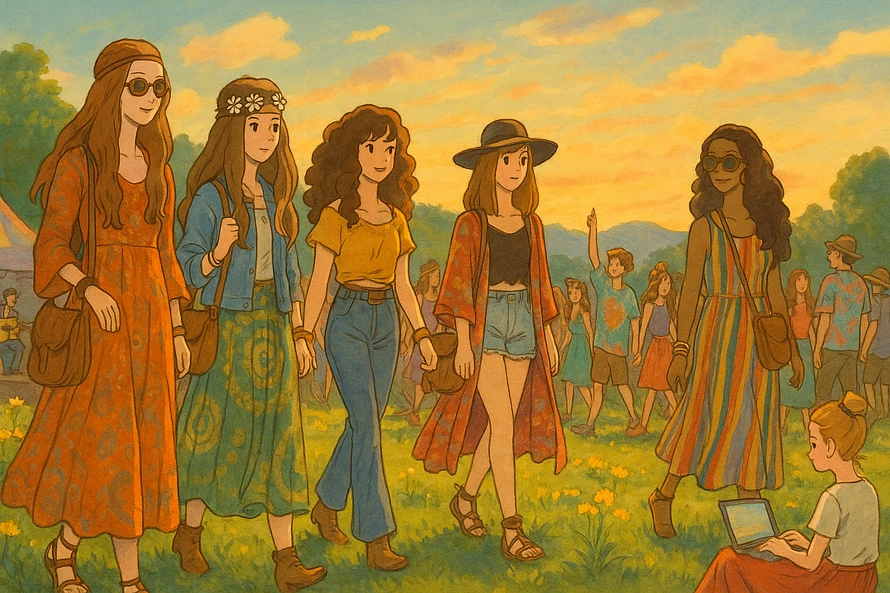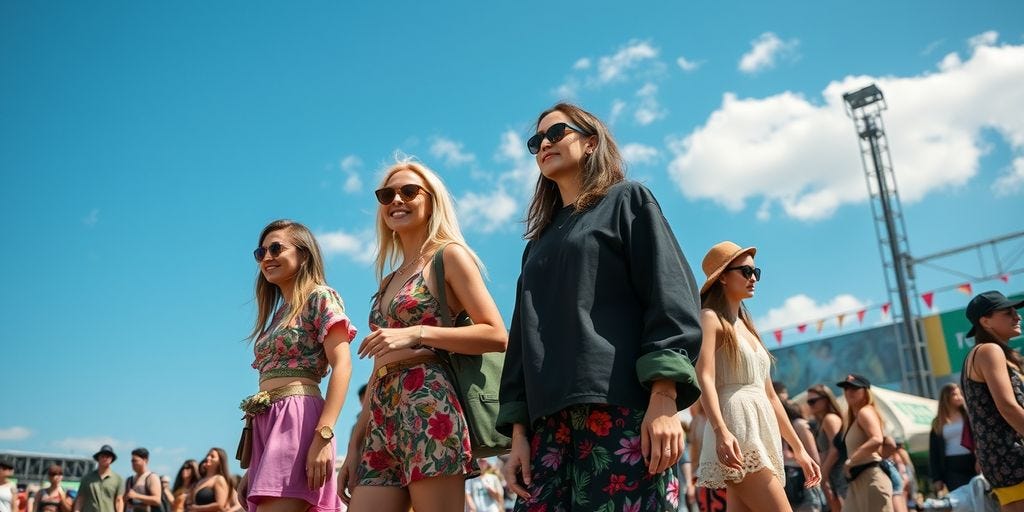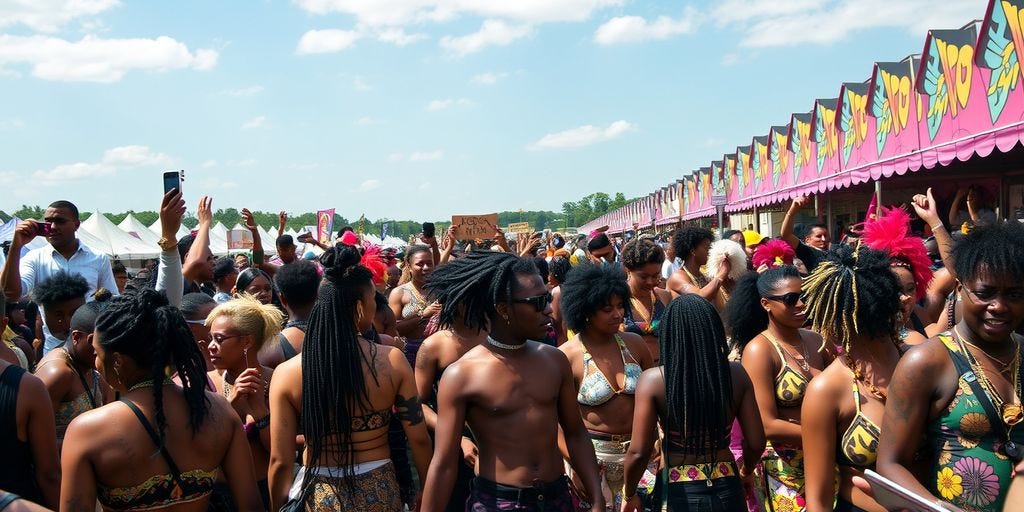Festival Fashion: From Woodstock to Today
Festival fashion has always been more than just clothes; it’s a reflection of the times, the music, and the people. From the free-spirited looks of Woodstock in 1969 to today’s eco-friendly and tech-enhanced styles, festival fashion has evolved dramatically.
Let’s take a journey through the decades to see how festival fashion has changed and what has stayed the same.
Woodstock: The Birth of Festival Fashion
Woodstock 1969 wasn’t just a music festival; it was a cultural revolution. The fashion at Woodstock set the stage for what we now call festival fashion. It was all about freedom, self-expression, and breaking away from societal norms.
Hippie Style Essentials
At Woodstock, both men and women embraced a laid-back, bohemian style. Think frayed bell-bottomed jeans, tie-dyed shirts, and headbands. Footwear was optional, with many choosing to go barefoot or wear simple sandals.
Accessories like bead necklaces and flower crowns were also popular.
DIY and Handmade Trends
One of the coolest things about Woodstock fashion was the DIY aspect. People made their clothes, often from recycled materials. This not only made each outfit unique but also added a personal touch. Crochet tops, handmade jewelry, and patched-up jeans were all the rage.
Cultural Influences
The fashion at Woodstock was heavily influenced by various cultures. From Native American-inspired fringe to Indian paisley prints, the styles were as diverse as the people wearing them. This mix of cultural elements created a rich tapestry of fashion that was both eclectic and inclusive.
The Evolution of Festival Fashion in the 70s and 80s
Punk and Rock Influences
The 1970s saw a rise in countercultural fashion that seeped into the music festival scene.
This decade gave rise to punk culture, an anti-establishment lifestyle that manifested in both music and fashion. Rock Against Racism’s multi-gig festivals all around Britain featured bands like The Clash and artists such as Elvis Costello.
Attendees were correspondingly dressed in edgy, heavy metal outfits that included ripped band tees, leather jackets, worker boots, safety pins, and metal studs.
Vivienne Westwood and Malcolm MacLaren’s booming punk rock boutique played a large role in pushing this punk fashion revolution.
Glam and Neon Trends
Unlike the rebellious spirit of the ‘60s and ‘70s, the festivals of the 1980s embraced a more happy-go-lucky feel that’s typically associated with the colorful, pop music and fashion of this decade.
The now-famous Glastonbury music festival began in 1981, but several charitable concerts such as Live Aid drew in crowds of neon tutus, square Ray-ban sunglasses, polyester tracksuits, legwarmers, slogan tees, and layered jewelry.
Iconic Festival Moments
The 70s and 80s were full of iconic festival moments that shaped fashion. From the punk rock looks at Rock Against Racism to the neon extravaganza at Live Aid, these decades were all about bold self-expression.
Festivals became a place where people could escape daily life and be whoever they wanted to be, even if just for a few days.
90s Grunge and Alternative Styles
Lollapalooza’s Impact
In the early ’90s, the festival scene got a fresh vibe with the birth of Lollapalooza in 1991. Organized by Jane’s Addiction, this festival was a game-changer. It brought together different music genres like rap, punk, and rock, breaking down the usual boundaries.
This mix of styles sparked the alternative rock explosion in the USA. The festival became a haven for disaffected youth who were tired of the mainstream.
Signature Grunge Pieces
Grunge fashion was all about that laid-back, do n’t-care attitude. Inspired by icons like Kurt Cobain, festival-goers rocked long hair, oversized T-shirts, and ripped jeans.
Army boots and skateboard-friendly sneakers were a must. The look was completed with hole-ridden flannels and thrifted finds. It was a style that screamed rebellion and a rejection of societal norms.
Britpop and Festival Fashion
While America had grunge, the UK was all about Britpop. This scene celebrated British culture with a nod to the Swinging Sixties. Bands like Oasis and Blur were at the forefront, and their fans followed suit.
Union Jack flags, bucket hats, and Harrington jackets were everywhere. Britpop brought a cleaner, more mainstream take on alternative rock, contrasting sharply with America’s grunge scene.
2000s Celebrity Influence on Festival Fashion
Sienna Miller and Kate Moss
At the start of the 2000s, tabloid culture and technology turned music festivals into global events.
People started paying as much attention to what their favorite celebrities wore as they did to the artists themselves. Two cultural icons, Sienna Miller and Kate Moss, forever changed festival fashion during this decade.
When Sienna Miller stepped out in a frayed denim dress, neon yellow sunglasses, a gold-coined belt, and Ugg boots at Glastonbury 2004, the world instantly adored her ability to look effortlessly chic.
The next year, Kate Moss topped the frenzy with a glitzy gold dress, a low-waisted belt, and a pair of Hunter boots. These looks were not just outfits; they were fashion statements that set trends for years to come.
Tabloid Culture and Style
The rise of social media and the high street brand’s ability to quickly replicate celeb style made festival fashion more accessible. Magazines and social media platforms were flooded with images of celebrities in their festival best, making it easy for fans to emulate their favorite stars.
This era saw the birth of the “festival aesthetic,” where the focus shifted from self-expression to fitting a particular look. Brands capitalized on this by mass-producing festival-ready outfits, making it easier for everyone to look like their favorite celebrities.
The Rise of Coachella
Coachella became the ultimate festival for celebrity sightings and fashion statements. Influencers and celebrities took sponsored trips and flaunted their outfits in promotional Instagram posts.
The festival became a runway, with everyone from Paris Hilton to Vanessa Hudgens showcasing their best looks.
Fast fashion brands pumped out the latest trends, from fringed denim to neon sunglasses, making festival fashion highly commercialized. The focus was no longer just on the music but also on the outfits, turning Coachella into a fashion event as much as a music festival.
The Commercialization of Festival Fashion in the 2010s
Fast Fashion’s Role
In the 2010s, festival fashion became a huge business. Fast fashion brands like H&M and Zara saw a big chance to make money. They started making special collections just for festivals.
These clothes were often cheap and made to be worn only once. This led to a lot of waste, but people loved the trendy looks.
Influencer Culture
Social media influencers played a big part in this change. They would go to festivals like Coachella and post pictures of their outfits. Brands paid them to wear their clothes, making festival fashion even more popular. Everyone wanted to look like their favorite influencer.
Cultural Appropriation Issues
One big problem with festival fashion in the 2010s was cultural appropriation. People started wearing items like Native American headdresses and bindis without understanding their cultural importance. This was seen as disrespectful and led to a lot of criticism.
Festival fashion in the 2010s became more about looking good for social media than about self-expression or enjoying the music. This shift changed the way people thought about festivals and what they wore to them.
Modern Festival Fashion: Sustainability and Innovation
Eco-Friendly Trends
Festival fashion is shifting towards sustainability, with many opting for eco-friendly choices. Swapping out microplastic glitter for biodegradable options is a small but impactful change.
Brands are now focusing on sustainable materials like organic cotton and recycled fabrics. Here are some ways to keep your festival outfits green:
-
Choose biodegradable wet wipes.
-
Support eco-friendly brands.
-
Opt for second-hand or vintage clothing.
Tech-Enhanced Clothing
Tech is making its way into festival fashion, offering both style and function. Imagine clothes that can charge your phone or light up at night. These innovations are not just cool but also practical, especially for long festival days. Some tech-enhanced clothing options include:
-
Solar-powered jackets.
-
LED-embedded outfits.
-
Smart fabrics that adjust to temperature changes.
Future of Festival Style
The future of festival fashion looks promising with a focus on sustainability and innovation. From cardboard to couture, festival fashion shows are now highlighting a fusion of creativity and eco-consciousness.
Expect to see more brands adopting sustainable practices and tech innovations becoming mainstream. The goal is to enjoy festivals while being kind to the planet.
Festivals are a way to escape, but more importantly, they are a way to connect with ourselves, our friends, and the world around us.
Afropunk and the Celebration of Diversity
Afropunk is more than just a music festival; it’s a celebration of diversity and a safe space for Black communities to express themselves. Founded in 2005 by James Spooner and Matthew Morgan, Afropunk started as a haven for Black people in the predominantly white punk scene.
Over the years, it has grown to include a variety of music genres, from neo-soul to hip-hop, and has expanded globally, with events in cities like Berlin, Paris, and Johannesburg. The festival’s influence skyrocketed when Jocelyn Cooper joined and took it international.
Afrocentric Styles
At Afropunk, fashion is a form of self-expression. Attendees often blend traditional African attire with modern elements, creating unique looks that celebrate their heritage.
From vibrant prints to intricate hairstyles, the festival is a visual feast of Afrocentric styles. It’s a place where Black excellence is on full display, and everyone is encouraged to be their authentic selves.
Streetwear and Punk Fusion
Afropunk’s roots in the punk scene are still evident today. Many festival-goers mix streetwear with punk elements, creating a fusion that’s both edgy and culturally significant.
Think leather jackets paired with African beads or combat boots with colorful dashikis. This blend of styles not only looks cool but also tells a story of cultural fusion and resilience.
Cultural Significance
Afropunk is more than just a festival; it’s a movement. It provides a platform for Black artists and creators to showcase their talents and for attendees to connect with their roots.
The festival’s motto, “No sexism, no racism, no ableism, no ageism, no homophobia, no fatphobia, no transphobia, no hatefulness,” speaks volumes about its commitment to inclusivity and diversity. In a world where Black and brown people can often feel overlooked, Afropunk is a place where they are celebrated and uplifted.
Afropunk continues its tradition of celebrating the rich diversity of the Black diaspora, redefining modern cultural experiences, and providing a vibrant space for self-expression.
From the free-spirited vibes of Woodstock to the influencer-driven looks of today’s festivals, festival fashion has come a long way. Back in the ’60s, it was all about expressing rebellion and unity through handmade and eclectic outfits. Fast forward to now, and while the essence of self-expression remains, there’s a lot more commercial influence.
Brands and social media have turned festival fashion into a big business, but the heart of it still beats with creativity and individuality. So, whether you’re rocking tie-dye or neon, remember that festival fashion is all about having fun and being yourself.


